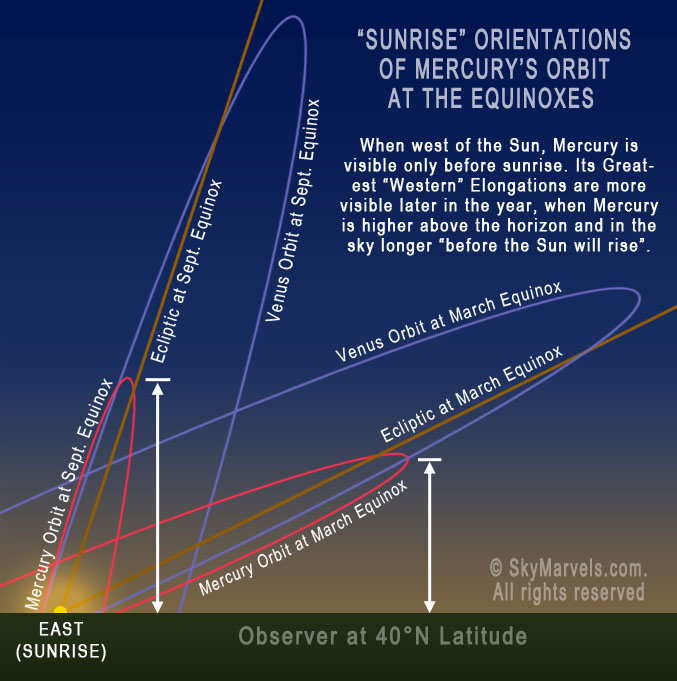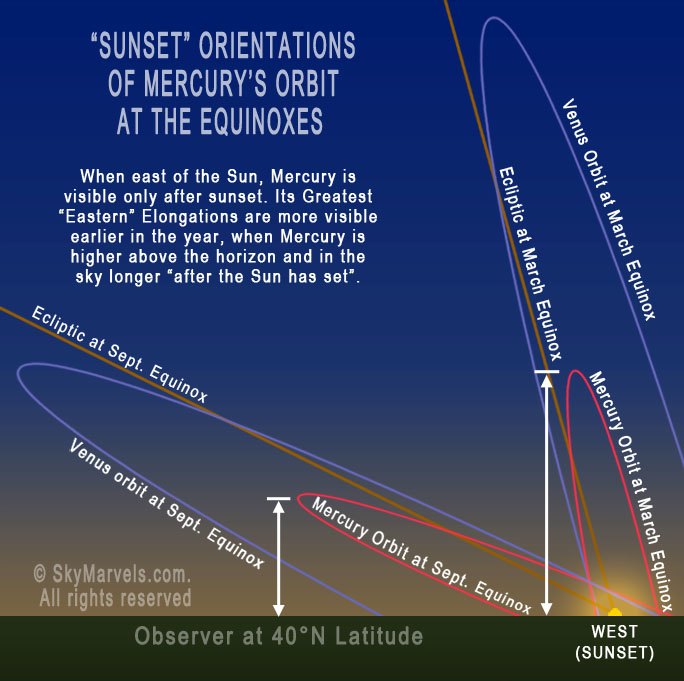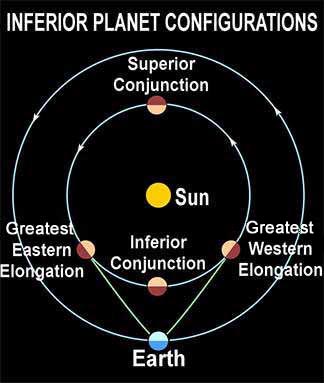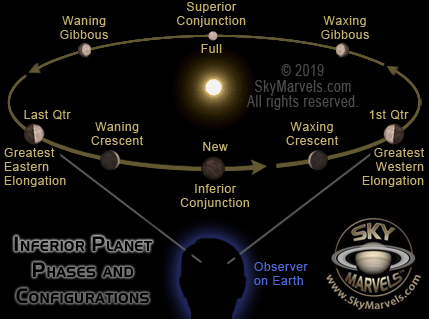
MERCURY'S GREATEST ELONGATIONS OF 2020
Wide FOV Image Credits: NASA/JPL Solar System Simulator developed by: David Seal
L O A D I N G 
Click on the labels directly above to view Mercury at its Greatest Elongations of 2020, the times when it appears farthest from the Sun in our skies. These are the best times to view this elusive planet, which often appears so close to the Sun that it is lost in the brightness of our parent star. Above you can view Mercury's Greatest Elon- gations with or without orbits, and zoom in to see how the planet will appear "close-up" on those dates. The ex- ample on 2020 November 10 is particularly interesting, as it occurs during one of the two times each year (early
May and early November) when Mercury's orbit appears "edge on" to us here on Earth.
Remember that Mercury and Venus are the only two major planets that exhibit greatest eastern and western elon- gations because they are Inferior Planets—that is, their orbits are smaller than Earth's. In contrast, the Superior Planets, whose orbits are larger than Earth's, can at times appear directly opposite the Sun in our skies. If you are viewing Mercury on the date of a Greatest Elongation, also check out its Current Location in Orbit and Current Location in the Constellations, and compare these to what you are seeing in the above views.
 WARNING ! Mercury always appears close to the Sun. As It is never safe to look directly at the real Sun with the naked eye, and as looking at the Sun through a telescope or binoculars without adequate safeguards—even for an instant—can cause permanent blindness, NEVER attempt to view Mercury while the Sun is visible! With a telescope or binoculars especially, you run the risk of inadvertantly focusing on the Sun! To learn how to safely "observe" Mercury, consult the professionals at your local planetarium or observatory.
WARNING ! Mercury always appears close to the Sun. As It is never safe to look directly at the real Sun with the naked eye, and as looking at the Sun through a telescope or binoculars without adequate safeguards—even for an instant—can cause permanent blindness, NEVER attempt to view Mercury while the Sun is visible! With a telescope or binoculars especially, you run the risk of inadvertantly focusing on the Sun! To learn how to safely "observe" Mercury, consult the professionals at your local planetarium or observatory.
When you examine the above views—all shown at the same scale and with the same FOV (Field of View)—it is easy to conclude that Mercury's orbit is considerably elliptical. As the year progresses and Earth moves in its orbit around the Sun, Mercury's successive greatest elongations can be seen to be irregular, both in their timing and in their apparent angular distances from the Sun. This is because from Earth we see Mercury's oblong and tilted orbit at different angles in different months. For example, one after another look at the succeeding "Eastern" Elongations presented above. Their varying angular distances from the Sun are quite obvious.
As varied as these angular distances are, from our earthly perspective Mercury can never appear more than 28° from the Sun! This fact has important implications concerning the times when Mercury can be observed in our skies. Whenever Mercury is east of the Sun it is only visible at or just after sunset, and whenever it is west of
the Sun it is only visible at or just before sunrise. At all other times Mercury is either a.) outshined by the Sun's brilliance and therefore invisible to us, or b.) below our horizon. For these reasons most persons have probably never seen this enigmatic planet! In fact, due to Mercury's cycle—of appearing east of the Sun, then disappearing, then appearing west of the Sun, then disappearing again—the ancients believed that Mercury was two planets!
 Now you may think that Mercury is easiest to observe when it "appears" farthest from the Sun. But this is not necessarily so. Due to the varying "apparent" tilt of the Ecliptic as Earth rotates on its axis and orbits the Sun, there are times when a narrower Greatest Elongation presents more favorable viewing opportunities than a wider one! The images
Now you may think that Mercury is easiest to observe when it "appears" farthest from the Sun. But this is not necessarily so. Due to the varying "apparent" tilt of the Ecliptic as Earth rotates on its axis and orbits the Sun, there are times when a narrower Greatest Elongation presents more favorable viewing opportunities than a wider one! The images
to the left and below show us why this is so.
When Mercury is west of the Sun, it is visible only at or before sunrise—never for more than 2 hours, and most often for considerably less. Moreover, viewed to the east near sunrise in autumn, the Ecliptic is more nearly vertical at the horizon than it is earlier in the year. This is simply a consequence of Earth's 23.44° tilt relative to its own orbit. As the major planets never wander far from the Ecliptic, at sunrise Mercury's orbit too appears more vertical at the horizon during autumn. This means that, compared to earlier in the year, if a Greatest "Western" Elongation occurs during autumn,
 Mercury is higher above the horizon and vis- ible in the sky longer "before the Sun rises". It likewise means that Mercury's Greatest "Western" Elongations are easier to witness later in the year!
Mercury is higher above the horizon and vis- ible in the sky longer "before the Sun rises". It likewise means that Mercury's Greatest "Western" Elongations are easier to witness later in the year!
The opposite situation occurs for Mercury's Greatest "Eastern" Elongations. It is during "spring" and near "sunset", when—looking west—the Ecliptic is more vertical to the horizon. This is when—if Mercury is east of the Sun—it is higher above the horiizon and visible in the sky longer "after the Sun sets". The effect of this is that Mercury's Greatest "Eastern" Elongations are easier to witness earlier in the year.
Comparing Mercury's Greatest Elongations
of February 10 and March 24 provides a good example of what is noted above. On Feb 10, when the fleet planet is nearing perihelion, it appears only 18.2° "east" of the Sun. Yet an observer at 40° North Latitude is able to view Mercury for about an hour and a half "after
the Sun has set". However, on Mar 24, when Mercury is approaching aphelion, it appears a whopping 27.8° "west" of the Sun. Yet an observer at 40° North Latitude is able to view it for only about an hour "before the Sun rises!" So, yes, the time of year definitely does matter, when you observe Mercury's Greatest Elongations.
Now all this talk of east and west, and Eastern and Western, and where to look in the sky, all might seem a little confusing at first. Just keep in mind that the terms "Eastern" and "Western" refer to where Mercury appears in our skies "relative to the Sun". To view Mercury's Greatest "Eastern" Elongations, therefore, you look toward the "west" in the early evening, because that is when Mercury is visible in the sky after sunset! Conversely, to view Mercury's Greatest "Western" Elongations, you look toward the "east" in the early morning, because that is when Mercury is visible in the sky before sunrise! The chart and diagram below should help clarify matters.
MERCURY'S GREATEST ELONGATIONS
type are viewed . . . are easier to witness . . .
"Western" before sunrise (looking east) "later" in the year!
"Eastern" after sunset (looking west) "earlier" in the year!
The two diagrams below highlight the overall geometries of Mercury's elongations, configurations and phases as an Inferior Planet. Gain further insight with this Configurations Simulator and this Planetary Phases Simulator. In both simulators' Orbit Sizes boxes, select Earth as "observer" and Mercury as "target".


You can easily and quickly generate a table of each year's six or seven Greatest Elongations of Mercury hundreds of years into the past and future with the Mercury Chaser's Calculator.
And while you're at it checking out Mercury's Elongations, don't forget that you can also find when viewing the "other" Inferior Planet is optimum. Check out Venus's Greatest Elongations of 2020.
Simulator Image Notes: 1) Fields of View are measured horizontally. 2) Eclipse shadows of planetary moons are not displayed. 3) Light-Travel Time is not included in calculated times. 4) Planet of focus (at center of simulator image) is viewed with its local north "upward", i.e. in the 12:00 midnight direction. 5) Simulator expresses the phase (where applicable) as the absolute value of the phase angle.
Note: zoomed views of Mercury were generated with Celestia 1.6.1 and show accurate representations of the planet's surface.
Home Intro News Gallery Sky-Gifts Bonuses Tips
Learning Ctr Help Links Credits Legal Contact Us
© 2007-
by Gary M. Winter. All rights reserved.
Interested in political cartoons and humor?
Check out The HIPPLOMATS™.
SkyMarvels, Sky Marvels, SkyMarvels.com, Current Year's Greatest Elongations of Mercury, Mercury's Greatest Elongations for Current Year, celestiaforall, CELESTIA, astronomy, space, simulations, animations, downloadable astronomy posters, stars, planets, Inner Planets, Outer Planets, Inferior Planets, Superior Planets, moons, asteroids, comets, Oort Cloud, galaxy, galaxies, Milky Way, Andromeda, globular clusters, binaries, quasars, black holes, supermassive black holes, telescope, telescopes, planetarium, software, freestuff, satellites, add-ons, addons, scripts, eclipses, Solar Eclipses, Lunar Eclipses, Solar Eclipse Finder, Lunar Eclipse Finder, mutual eclipses, transits, occultations, Solar System, CELES-TOOLS, celeSTARrium, CELX, CELX programming, Freebies, multiple views, atronomical unit, light year, parsec, meteors, meteor showers, Perseids, Geminids, Leonids, barycenter, time, Time Zones, tides, alignments, conjunctions, oppositions, seasons, apogees, perigees, aphelion, perihelion, Earth, Luna, Mercury, Venus, Mars, Jupiter, Galilean Moons, Io, Europa, Ganymede, Callisto, Saturn, Titan, rings, Uranus, Neptune, Triton, E-MSpectrum, electromagnetic spectrum, astronaut, equinoxes, solstices, precession, rotation, spin, inclination, tilt, Ecliptic, orbits, ellipse, parabola, hyperbola
